Denis Calvaert | |
|---|---|
 The miracle of Saint Catherine | |
| Born | Denys Calvaert c. 1540 |
| Died | 16 April 1619 (aged 78–79) |
| Nationality | Flanders |
| Other names | Dionisio Fiammingo Il Fiammingo |
| Known for | Painting |
| Movement | Baroque |
Denis (or Denys or Denijs) Calvaert (Dutch: [ˈkɑlvaːrt]; around 1540 – 16 April 1619) was an Antwerp-born Flemish painter, who lived in Italy for most of his life, where he was known as Dionisio Fiammingo[1] (Italian: [djoˈniːzjo fjamˈmiŋɡo]) or simply Il Fiammingo ("the Fleming"). Calvaert was a profound student of architecture, anatomy, and history. His works are characterized by their advanced composition and colouring.
Calvaert is well known for his drawings and small copper paintings.
Some of his best known works include his rendition of The Resurrection of Christ[2] and Saint John the Baptist in the Wilderness.[3]
Biography
After studying landscape-painting for some time in his native city[4] (the Antwerp "Record of Artists" or "Liggeren" (1556–57), gives his name as Caluwaert), he first studied under Christiaen van Queecborn.
He then went to Bologna, where he apprenticed under Prospero Fontana. His paintings acquired the mannerism of Flemish art and appeared to be the work of an Italian. From Bologna he went to Rome in 1572, where he assisted Lorenzo Sabbatini in his works for the papal palace of the Vatican, and devoted much of his time to copying and studying the works of Raphael Sanzio.[4]
He returned to Bologna and founded a studio. He had a number of prominent young apprentices, including Guido Reni, Giovanni Battista Bertusio, Francesco Albani and Domenichino,[5] who soon followed Annibale Carracci's example and took prominent commissions in Rome. Vicenzio Gotti, Francesco Gessi,[6] and Giacomo Semenza also worked in his studio, before joining the studio of Guido Reni. Vincenzo Spisanelli and Gabriello Ferrantini worked under Calvaert as well.[7]
Calvaert was respected by his fellow citizens in Bologna and by his colleagues, as shown by the presence of Ludovico Carracci, then leader of a competing studio, accompanied by all of his students, at Calvaert's funeral in the Basilica di Santa Maria dei Servi.
Style and legacy
Calvaert typically used chiaroscuro techniques to set stylized foreground figures derived from Correggio against northern European landscapes. His use of colour also reflects the influence of Barocci. While continuing to pursue a mannerist aesthetic throughout his career, Calvaert became a significant contributor the brand of classicism that came to characterize the Bolognese school of painting from the start of the 17th century.[8]
His principal works are to be seen at Bologna, Florence, St. Petersburg, Parma, and Caen. Some of his paintings were lost in WWII and therefore only his etchings of those pieces remain. Calvaert's painting of The Holy Family and Saint John the Baptist was one of the few that was returned to the family through Nazi-Era Provenance Research.[9]
Many of his pieces are on display at the National Art Gallery of Bologna, while "St Michael", one of his most renowned works is displayed at the Basilica of San Petronio.[5]
Other paintings and drawings by Calvaert can be found at the Louvre in Paris (under Dionys Calvaert), The Met Museum in New York (under Denijs Calvaert), The British Museum, The Morgan, Museo Nacional del Prado, and the Museum & Gallery in Greenville, South Carolina.
Works
_-_The_Assumption_of_the_Virgin_-_RCIN_405738_-_Royal_Collection.jpg.webp) The Assumption of the Virgin, Royal Art Collection
The Assumption of the Virgin, Royal Art Collection The Conversion of Saint Paul (Museum of Fine Arts, Budapest)
The Conversion of Saint Paul (Museum of Fine Arts, Budapest) Mystic Marriage of Saint Catherine
Mystic Marriage of Saint Catherine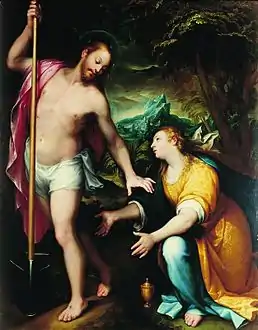 Noli me tangere
Noli me tangere Death of Saint Peter Martyr (Denijs Calvaert)
Death of Saint Peter Martyr (Denijs Calvaert)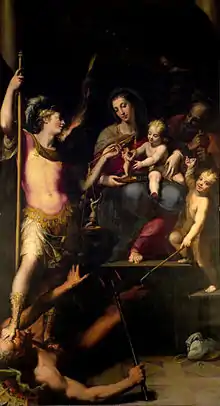 Holy Family with Saint John and Archangel Michael, San Giacomo Maggiore, Bologna
Holy Family with Saint John and Archangel Michael, San Giacomo Maggiore, Bologna.jpg.webp) Mystical Marriage of Saint Catherine
Mystical Marriage of Saint Catherine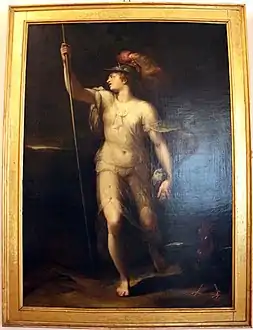 La Vigilanza by Denijs Calvaert
La Vigilanza by Denijs Calvaert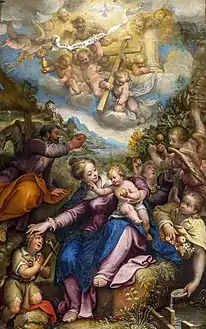 Rest on the Flight into Egypt
Rest on the Flight into Egypt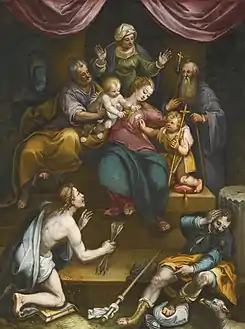 Holy Family with Saint John the Baptist and Saint Anne
Holy Family with Saint John the Baptist and Saint Anne The Holy Family with the Infant Saint John the Baptist (National Galleries of Scotland)
The Holy Family with the Infant Saint John the Baptist (National Galleries of Scotland) Virgin and Child in a Rocky Landscape
Virgin and Child in a Rocky Landscape San Giovanni Evangelista
San Giovanni Evangelista
Notes
- ↑ "Calvaert "kàlvaart", Denijs, detto Dionisio Fiammingo". Treccani (in Italian). Retrieved 3 December 2013.
- ↑ "The Resurrection of Christ by Denijs Calvaert (The Met Museum)". The Met Fifth Avenue. The Met Museum in New York, NY. Archived from the original on 17 October 2021.
- ↑ "Saint John the Baptist in the Wilderness by Denys Calvaert, c. 1540-1619". Art Institute of Chicago. artic.edu. Archived from the original on 25 September 2020.
- 1 2 One or more of the preceding sentences incorporates text from a publication now in the public domain: Chisholm, Hugh, ed. (1911). "Calvart, Denis". Encyclopædia Britannica. Vol. 5 (11th ed.). Cambridge University Press. pp. 69–70.
- 1 2 Wood, James, ed. (1907). . The Nuttall Encyclopædia. London and New York: Frederick Warne.
- ↑ Orlandi, Pellegrino Antonio; Guarienti, Pietro (1719), Abecedario pittorico, Naples, p. 165
- ↑ Hobbes, James R. (1849). Picture collector's manual adapted to the professional man, and the amateur. London: T&W Boone. p. 33.
- ↑ Van Miegroet, Hans J. "Calvaert, Denys". Oxford Art Online. Oxford University Press. Retrieved 3 December 2013. (subscription required)
- ↑ "The Holy Family With Saint John The Baptist – The Hood Museum (Dartmouth University)". Dartmouth – Hood Museum. hoodmuseum.dartmouth.edu. Archived from the original on 20 January 2021.
References
 This article incorporates text from a publication now in the public domain: Herbermann, Charles, ed. (1913). Catholic Encyclopedia. New York: Robert Appleton Company.
This article incorporates text from a publication now in the public domain: Herbermann, Charles, ed. (1913). Catholic Encyclopedia. New York: Robert Appleton Company. {{cite encyclopedia}}: Missing or empty|title=(help)
External links
 Media related to Denys Calvaert at Wikimedia Commons
Media related to Denys Calvaert at Wikimedia Commons- Denys Calvaert On-Line. ArtCyclopedia.